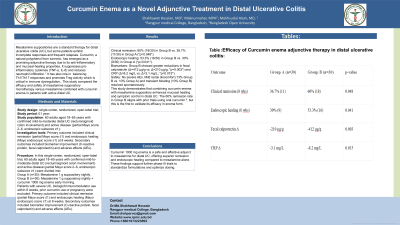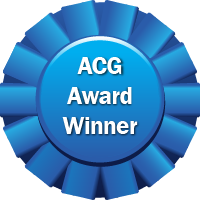Monday Poster Session
Category: IBD
P3255 - Curcumin Enema as a Novel Adjunctive Treatment in Distal Ulcerative Colitis
Monday, October 27, 2025
10:30 AM - 4:00 PM PDT
Location: Exhibit Hall

Has Audio

Md. Shakhawat Hossain, MD
Rangpur medical college
Rangpur, Rangpur, Bangladesh
Presenting Author(s)
Award: ACG Presidential Poster Award
Md. Shakhawat Hossain, MD1, Maknun Nahar, MPH2, Md. Makhsudul Alam, MD1
1Rangpur medical college, Rangpur, Rangpur, Bangladesh; 2Bangladesh Open University, Rangpur Sadar, Rangpur, Bangladesh
Introduction: < !Mesalamine suppositories are a standard therapy for distal ulcerative colitis (UC), but some patients exhibit incomplete responses and frequent relapses. Curcumin, a natural polyphenol from turmeric, has emerged as a promising adjunctive therapy due to its anti-inflammatory and mucosal-healing properties. It suppresses pro-inflammatory cytokines (TNF-α, IL-6), reduces neutrophil infiltration1 and restores tight junction proteins (e.g., occludin). 2 These mechanisms align with the localized pathology of distal UC and maximize therapeutic impact. 3 This study compared the efficacy and safety of mesalamine suppository monotherapy versus mesalamine combined with curcumin enema in patients with active distal UC.
Methods: In this single-center, randomized, open-label trial, 60 adults aged 18–65 years with confirmed mild-to-moderate distal UC (rectum/sigmoid colon involvement) and active disease (partial Mayo score 2–6, endoscopic score ≥1) were divided into:
Group A (n=30): Mesalamine 1 g suppository nightly.
Group B (n=30): Mesalamine 1 g suppository nightly + curcumin 1g enema early morning.
Primary outcome included clinical remission and endoscopic healing (Mayo endoscopic score ≤1) at 8 weeks. Secondary outcomes included biomarker improvement (CRP, fecal calprotectin) and adverse effects (AEs).
Results: Clinical remission: 60% (18/30) in Group B vs. 36.7% (11/30) in Group A (*p=0.048*).
Endoscopic healing: 53.3% (16/30) in Group B vs. 30% (9/30) in Group A (*p=0.041*).
Biomarkers: Group B showed greater reductions in fecal calprotectin (Δ=412 μg/g vs. Δ=210 μg/g; *p=0.003*) and CRP (Δ=8.2 mg/L vs. Δ=3.1 mg/L; *p=0.015*).
Safety: No severe AEs. Mild rectal discomfort (13% Group B vs. 10% Group A) and transient bloating (10% Group B) resolved spontaneously.
Discussion: This study demonstrates that combining curcumin enema with mesalamine suppository enhances mucosal healing and symptom control in distal UC. The 60% remission rate in Group B aligns with prior trials using oral curcumin 4, but this is the first to validate its efficacy in enema form. Cardinal findings include:
1. Mechanistic Synergy: Curcumin’s NF-κB inhibition complements mesalamine’s anti-inflammatory effects, amplifying mucosal repair.
2. Localized Delivery: Direct enema administration bypasses curcumin’s poor oral bioavailability, achieving higher colonic tissue concentrations.
3.Safety: Minimal AEs reinforce curcumin’s role as a low-risk adjunct, even in biologic-refractory cases (e.g., sample case studies).

Disclosures:
Md. Shakhawat Hossain, MD1, Maknun Nahar, MPH2, Md. Makhsudul Alam, MD1. P3255 - Curcumin Enema as a Novel Adjunctive Treatment in Distal Ulcerative Colitis, ACG 2025 Annual Scientific Meeting Abstracts. Phoenix, AZ: American College of Gastroenterology.
Md. Shakhawat Hossain, MD1, Maknun Nahar, MPH2, Md. Makhsudul Alam, MD1
1Rangpur medical college, Rangpur, Rangpur, Bangladesh; 2Bangladesh Open University, Rangpur Sadar, Rangpur, Bangladesh
Introduction: < !Mesalamine suppositories are a standard therapy for distal ulcerative colitis (UC), but some patients exhibit incomplete responses and frequent relapses. Curcumin, a natural polyphenol from turmeric, has emerged as a promising adjunctive therapy due to its anti-inflammatory and mucosal-healing properties. It suppresses pro-inflammatory cytokines (TNF-α, IL-6), reduces neutrophil infiltration1 and restores tight junction proteins (e.g., occludin). 2 These mechanisms align with the localized pathology of distal UC and maximize therapeutic impact. 3 This study compared the efficacy and safety of mesalamine suppository monotherapy versus mesalamine combined with curcumin enema in patients with active distal UC.
Methods: In this single-center, randomized, open-label trial, 60 adults aged 18–65 years with confirmed mild-to-moderate distal UC (rectum/sigmoid colon involvement) and active disease (partial Mayo score 2–6, endoscopic score ≥1) were divided into:
Group A (n=30): Mesalamine 1 g suppository nightly.
Group B (n=30): Mesalamine 1 g suppository nightly + curcumin 1g enema early morning.
Primary outcome included clinical remission and endoscopic healing (Mayo endoscopic score ≤1) at 8 weeks. Secondary outcomes included biomarker improvement (CRP, fecal calprotectin) and adverse effects (AEs).
Results: Clinical remission: 60% (18/30) in Group B vs. 36.7% (11/30) in Group A (*p=0.048*).
Endoscopic healing: 53.3% (16/30) in Group B vs. 30% (9/30) in Group A (*p=0.041*).
Biomarkers: Group B showed greater reductions in fecal calprotectin (Δ=412 μg/g vs. Δ=210 μg/g; *p=0.003*) and CRP (Δ=8.2 mg/L vs. Δ=3.1 mg/L; *p=0.015*).
Safety: No severe AEs. Mild rectal discomfort (13% Group B vs. 10% Group A) and transient bloating (10% Group B) resolved spontaneously.
Discussion: This study demonstrates that combining curcumin enema with mesalamine suppository enhances mucosal healing and symptom control in distal UC. The 60% remission rate in Group B aligns with prior trials using oral curcumin 4, but this is the first to validate its efficacy in enema form. Cardinal findings include:
1. Mechanistic Synergy: Curcumin’s NF-κB inhibition complements mesalamine’s anti-inflammatory effects, amplifying mucosal repair.
2. Localized Delivery: Direct enema administration bypasses curcumin’s poor oral bioavailability, achieving higher colonic tissue concentrations.
3.Safety: Minimal AEs reinforce curcumin’s role as a low-risk adjunct, even in biologic-refractory cases (e.g., sample case studies).
Figure: Table:Efficacy of Curcumin enema adjunctive therapy in distal ulcerative colitis:

Figure: Table:Efficacy of Curcumin enema adjunctive therapy in distal ulcerative colitis:
Disclosures:
Md. Shakhawat Hossain indicated no relevant financial relationships.
Maknun Nahar indicated no relevant financial relationships.
Md. Makhsudul Alam indicated no relevant financial relationships.
Md. Shakhawat Hossain, MD1, Maknun Nahar, MPH2, Md. Makhsudul Alam, MD1. P3255 - Curcumin Enema as a Novel Adjunctive Treatment in Distal Ulcerative Colitis, ACG 2025 Annual Scientific Meeting Abstracts. Phoenix, AZ: American College of Gastroenterology.

